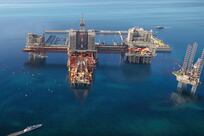BP's containment cap over its stricken Gulf of Mexico well is collecting about 1,000 barrels per day, the top US official overseeing the clean-up effort said today. A top BP executive overseeing containment efforts said as that collection rate increases, it could corral "90-plus per cent" of the oil. One thousand barrels is a small fraction of the 19,000 barrels per day that the US government has estimated could be gushing from the well, but the amount should increase as BP closes vents at the bottom of the cap to trap more oil, coast guard Admiral Thad Allen told reporters in a conference call.
"Sometime later today we'll probably be able to get ... an approximation of how much oil we are capturing," he said. The containment cap is BP's latest attempt to trap oil, after its' "top kill" plan to plug the well failed on Saturday. BP's strategy is now to trap the oil at the well and funnel it to a tanker on the surface until it can drill a relief well to staunch the flow, which could take until mid-August.
Doug Suttles, BP's chief operating officer of exploration and production, told CNN earlier on Today that the containment cap "should work". "I'd like to see us capture 90-plus per cent of this flow," Mr Suttles said. "I think that's possible with this design." Both Allen and Suttles said BP would continue working to seal the cap on jagged remnants of a pipe on equipment at the wellhead. "Of course what we have to do is work through the next 24 or 48 hours to optimize that. But that would be the goal ... We want to stop this oil from spilling to the sea," Mr Suttles said.
Mr Suttles was the first BP official to publicly discuss the cap - its latest attempt after a series of failures to try to contain a gushing oil and gas leak in the Gulf of Mexico. BP spent Thursday lowering the cap onto the jagged remnants of a pipe that had been sheared from the top of equipment at the wellhead. A rubber seal on the bottom of the cap is intended to capture most of the oil, but some is still expected to escape.
Meanwhile, drilling continues on two relief wells expected to intercept and plug the leaking well far beneath the seabed. Drilling began May 2 on the first relief well and May 16 on a second. Both are expected to be finished in August. * Reuters





